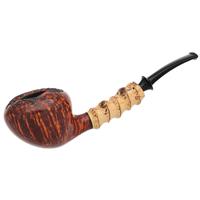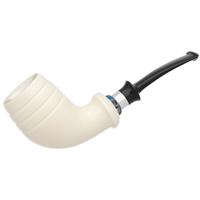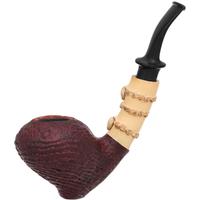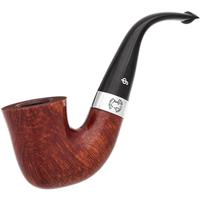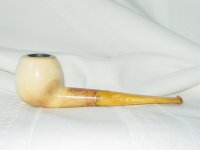Okay. There is just no way to get into the mindset of people from 1920.Depends on when the tenon gets drilled. Once the tenon is seated there's nothing to stop the dot from being drilled at the top. Evidently they just didn't see the necessity of doing that.
1920 Amber-stemmed Dunhill Without a White Spot
- Thread starter craiginthecorn
- Start date
You are using an out of date browser. It may not display this or other websites correctly.
You should upgrade or use an alternative browser.
You should upgrade or use an alternative browser.
Unless you're dealing with a century or older meer, chances are that it's not real amber but some form of amberoid, which may be more forgiving.For meerschaums with stuck amber stems I normally soak a pipe cleaner and push the end past the connection. If it doesn't work the first time I do it up to two more times. But I had a stuck one arrive yesterday and I could get a pipe cleaner through the bit opening, so it went straight into the freezer. I was surprised that it unscrewed with no effort.
Agreed. The case looks ~1900 but the mouthpiece looks post-1920. On the other hand, there are chips at the connection and it's not amberoid. And it fits the case perfectly. I'm guessing it's a well-executed ~1920 amber stem. This stuff can be head-scratching - I once purchased about thirty 'amber' stems, but the salt water float test culled out three imposters that I would have sworn were real amber. Close visual inspection with a magnifier and I could see my mistake. I'm 99% sure this one is real amber, but I'll do a float test when I get tired of watching football this weekend...and of course, I'll take picturesUnless you're dealing with a century or older meer, chances are that it's not real amber but some form of amberoid, which may be more forgiving.
From a collector's viewpoint, perhaps the most incredible Dunhill I've ever seen.Great story and a look at some history.
Thanks. One regret is that I didn't manage to remove the stem a year ago. My friend, Craig Cobine, was one of the foremost collectors of Dunhill pipes and tobacco and everything else associated with Dunhill, like clothing, jewelry, smoking accessories, store displays, and leather goods. He was also the director of the Chicago Pipe Show for a number of years. I had asked him about this pipe and he hadn't heard of Dunhill ever putting a dot on the tenon. He would've loved to have seen this one, but sadly, he passed away roughly six months ago.From a collector's viewpoint, perhaps the most incredible Dunhill I've ever seen.
Sorry to hear about your friend's passing.Thanks. One regret is that I didn't manage to remove the stem a year ago. My friend, Craig Cobine, was one of the foremost collectors of Dunhill pipes and tobacco and everything else associated with Dunhill, like clothing, jewelry, smoking accessories, store displays, and leather goods. He was also the director of the Chicago Pipe Show for a number of years. I had asked him about this pipe and he hadn't heard of Dunhill ever putting a dot on the tenon. He would've loved to have seen this one, but sadly, he passed away roughly six months ago.
At first it seems weird that the dot's on the tenon, but it really makes perfect sense - much safer that trying to add the dot after the stem is completed and risk fracturing the amber, or even trying to add the dot while the amber was rough cut. I can't recall ever seeing any insert added to a real amber stem.
Genuine amber has many different colors and levels of transparency. Clear or cloudy, reddish-brown, yellow, whitish, and even blue. All can be genuine amber. Some amber materials are actually a composite of amber pieces and/or powders which have been heated and pressed together or extruded, without need for any binders or fillers. Finally, there is bonded amber that, like the pressed amber, consists of pieces or powders, but which also includes a binding agent. Both block and pressed amber will pass the various simple tests for amber because, well, they’re amber. Bonded I’m not sure about.
This stem passes the two simplest tests — static and salt water flotation. In addition, Dunhill was founded as a luxury brand. It would be out of character for them to have used anything less than natural amber. The perfect registration of the mouthpiece to the shank and the lack of evidence of the shank being refinished suggests to me that the amber is original. The only thing that gives me pause is that the dot is not at 12 o’clock. I wonder if the maker thought that it might be worse to weaken the tenon at 12:00 rather than 2:00. It’s a semi-plausible explanation if you consider that some smokers like to tap their bowls on a knocker.
Although I can’t put my hands on one at the moment, I’m certain I’ve seen amber-stemmed Dunhill pipes from the 1920s which did have a white spot on the amber, but no doubt that they put it on the tenon to avoid damaging the amber.
This stem passes the two simplest tests — static and salt water flotation. In addition, Dunhill was founded as a luxury brand. It would be out of character for them to have used anything less than natural amber. The perfect registration of the mouthpiece to the shank and the lack of evidence of the shank being refinished suggests to me that the amber is original. The only thing that gives me pause is that the dot is not at 12 o’clock. I wonder if the maker thought that it might be worse to weaken the tenon at 12:00 rather than 2:00. It’s a semi-plausible explanation if you consider that some smokers like to tap their bowls on a knocker.
Although I can’t put my hands on one at the moment, I’m certain I’ve seen amber-stemmed Dunhill pipes from the 1920s which did have a white spot on the amber, but no doubt that they put it on the tenon to avoid damaging the amber.
Last edited:
Thanks for the interesting explanation. It mirrors my experience as well having a wide variation of amber and amber type stems. I haven’t seen one quite that shade. But that just reflects my lack of experience with English pipes and early Dunhills in particular.
Amber shows up in many different colors. The most common mistake I run across is the often described 'Cherry Amber' which usually turns out to be Redmanol. A lot of the pipes I post on here have amber stems and these are easy to spot since amber is hard on the teeth like glass, amberoid is not so brutal on the teeth and often shows up with tooth imprints on part of the mouthpiece.
We need a thread that compares cherry amber with Redmanol, and also swirly Bakelite such as @xrundog 's example, with authentic swirly amber like the stem in the OP's Dunhill, as well as what most old Petersons have.Amber shows up in many different colors. The most common mistake I run across is the often described 'Cherry Amber' which usually turns out to be Redmanol. A lot of the pipes I post on here have amber stems and these are easy to spot since amber is hard on the teeth like glass, amberoid is not so brutal on the teeth and often shows up with tooth imprints on part of the mouthpiece.
I've also seen some orange fake amber stems that are mostly opaque but have some swirl, which mimics a very similar type of amber. These are the type that fooled me but were revealed through the salt water test.
I'm currently taking pics of some of mine - I'll start another thread this weekend, so as not to distract from the OP's. If you don't get one started before me, I'll PM you when I start one.@runscott: I can post a few pictures if anyone is that interested!
That is a good one Jesse, will bear it in mind !Fabulous story with an exquisite pipe and a happy outcome. Can't beat that. And what a testament to the importance of that White Dot to Dunhill at that time.
You got lucky with the freezing and turning, that the amber didn't snap. It's brittle enough at room temperatures.
When I had a similar problem, RonnieB advised me on how to inject alcohol, a few drips at a time, into the seam between the stem and shank, to loosen up the tars that had built up. After about 45 minutes of this drip, drip, drip, I gave the amber stem a careful twist and it twisted right out like the day it was made.
Perhaps tape off stem and shank with electricity tape before doing drip, drip, drip ?
Not a bad idea. With mine, there was a sterling fitment in the way, so drip, drip drip it was.That is a good one Jesse, will bear it in mind !
Perhaps tape off stem and shank with electricity tape before doing drip, drip, drip ?
Will alcohol affect amber ?Not a bad idea. With mine, there was a sterling fitment in the way, so drip, drip drip it was.



